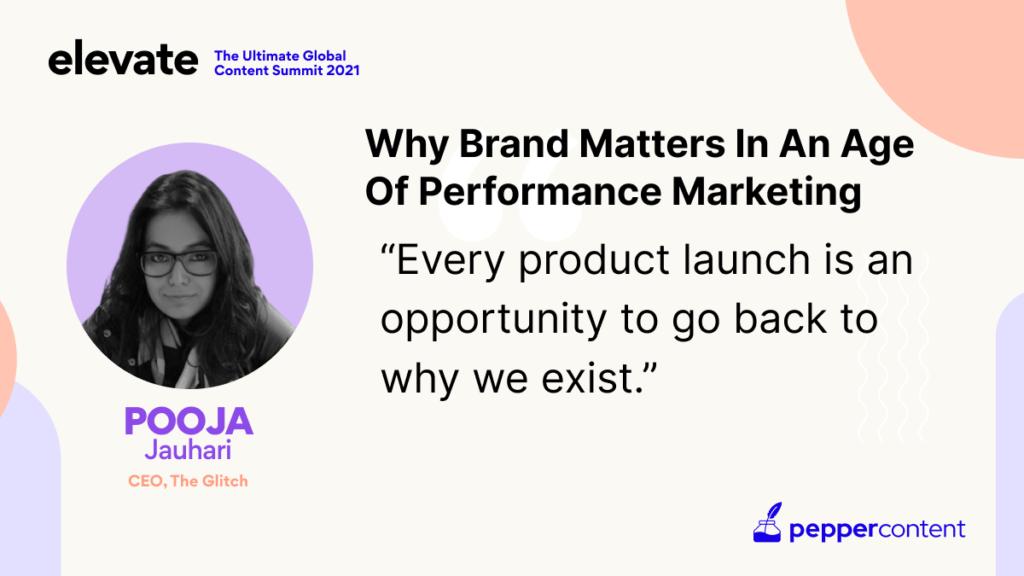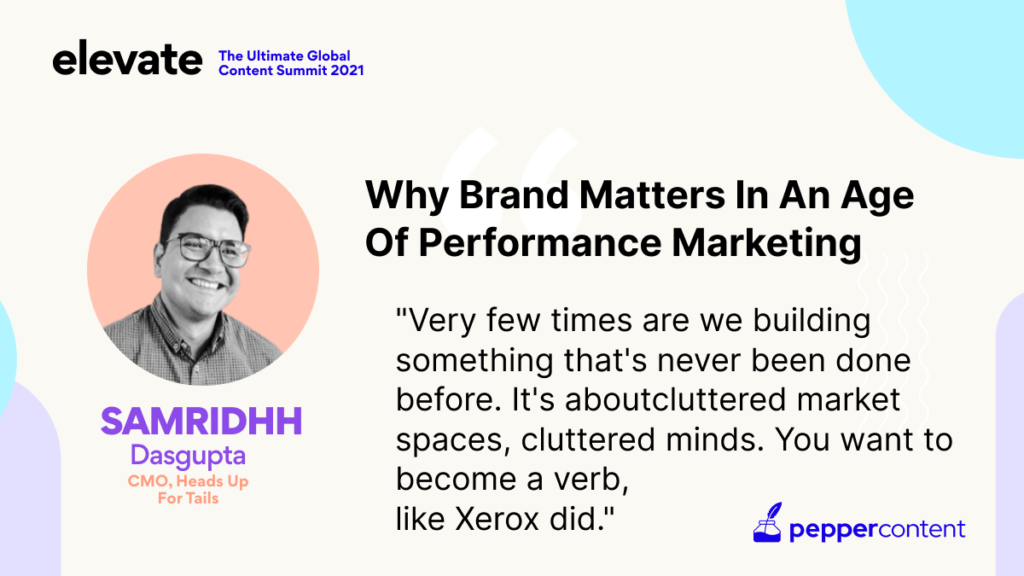Brand Building In The Age Of Performance Marketing

Brand and performance are two sides of the same coin. This blog has a combination of valuable inputs from Pooja Jauhari, CEO of The Glitch; Samridhh Dasgupta, CMO of Heads Up for Tails; and Suchita Salwan, CEO at LBB, who have dived deep into discussing different aspects of brand building, performance marketing, content marketing, and marketing in the digital age.
Branding is all about a company’s reputation and its overall value and trustworthiness, whereas performance is about concert data such as lead generation and conversions. As the world is witnessing a rapid change from traditional marketing to digital marketing, the strategies marketers have used erstwhile are no longer effective; we are sailing in an ocean of marketing revolution.
What is a Brand?
For the layperson, a brand is as simple as the logo and color a company chooses to represent itself. Reality is a lot more different and manifests the brand as the whole universe of marketing or a road map that guides a company to keep evolving in the short and long run.

A brand can simply be considered the overall genesis of a company and its existence. The brand tells customers what a company is all about, what they do, how they do it, and why they are different without any unnecessary fancy jargon. Our contributors point to a one-line definition of a brand, “A brand is how a company makes its customer feel about it and its offerings.”
How Does Positioning Complement The Brand?
A brand is a universe that combines all the company’s marketing activities. In contrast, positioning is a narrower aspect that beautifies the brand. It is very rare for a brand to be so inherently unique that it need not worry about positioning.
Positioning is all about being in the driver’s seat and showcasing your unique offering in a cluttered market. It is not as important to have a unique product as it is to position your brand uniquely. There lies the difference.
Positioning offers a certain degree of disproportionate advantage in a cluttered market, giving you a higher share of recalls.
How To Drive The Brand Forward?
To take the brand forward in the digital world where several channels can be leveraged to gain a competitive edge is a dramatic and complex process. There is no one-size-fits-all strategy for all brands. However, you can see success when the following crucial points are considered.
1. Maintain consistency
While the rapid shift from traditional to digital marketing opens the gates of using multiple platforms for multiple purposes, a brand can only build itself by maintaining clear consistency throughout the channels.
Whether it is a social media post or an ad on a search engine, the message should be clear and consistent. A brand must create and maintain one message and tone across different channels.
2. Evolve with your customers and their mindsets
Sharp marketing and brand building only come from listening to customers’ voices and being authentic, but keep in mind your initial objective and plan and sharpen that idea to be relevant. The basic idea of evolving with your customer is how a brand carries why it exists consistently and still be relevant to the time it is operating in.
3. Marry the brand and performance
Brand and performance are inseparable. Performance indicates how well a brand has been established and what measures should be taken to make it stand strong. Samridhh says, “There is no marketing if it is not performance marketing, and there is no way to get excellent performance if your brand is not right.”

4. Long term mindsets with short term impacts
To deliver a long-term impact, your short-term models should work effectively. These short-term goals are when your advertising campaign performs as you estimated, click-through rates are high, reviews and ratings are sought, and you have built the proper funnels. Once your short-term goals are analyzed and achieved, the long-term performance matrix will be on point.
5. Get comfortable with silence.
Overnight success is a myth in real-life scenarios. Your performance can be noisy and involve several people within a campaign or two.
However, while building a brand, there will be silence or whispers. Brand-building will take its time and requires a brand not to expect to reach the top in a short period. The key to building a strong brand is to get comfortable with the silence while delivering short-term impacts.
In stiff competition with plenty of brands entering the marketplace and plenty of new ways of targeting the customers, branding is a tool in every business’s belt. It is how you use it that matters. Branding is not about using fancy jargon to attract customers but maintaining a clear and consistent message to give customers a clear idea about what they are getting into.
While branding tells your customer what your business is all about, brand positioning helps them recall your brand when needed. Brand positioning is becoming more and more crucial with time, as the plethora of brands in the market are fighting to gain the same customers’ attention.
Brand positioning comes at the start and helps a brand stand at a distinctive spot in customers’ minds. As pointed out by the experts, the noisy marketplace makes it difficult for the brands to be heard by the right audience, and hence, it is crucial to have a distinct image with a unique tone.

Note: This blog is an excerpt from a session on Why Brand Matters in an Age of Performance Marketing with Pooja Jauhari, CEO of The Glitch; Samridhh Dasgupta, CMO of Heads Up for Tails; and Suchita Salwan, CEO at LBB. The session was part of Elevate–a global virtual content summit organized by Pepper Content, bringing together industry leaders in content marketing.
Latest Blogs
Explore how Google’s 2025 AI search updates triggered ranking chaos. Learn actionable strategies to adapt your SEO for AI Overviews, zero-click searches, and SERP volatility. Stay ahead now.
Learn how to rank on AI search engines like ChatGPT, Perplexity, and Gemini by optimizing your content for authority, structure, and relevance. Stay ahead in AI-driven search with this strategic guide.
Explore the best healthcare SEO services for your medical practice. Improve online visibility and effectively reach more patients in need of your services.
Get your hands on the latest news!
Similar Posts

Content Marketing
4 mins read
11 Best B2B Content Marketing Agencies for B2B Companies in 2024

Content Marketing
5 mins read
Top ecommerce Marketing Agencies with Proven Strategies for 2024

Content Marketing
5 mins read